Unbelievable ancient masonry from around the world
There are many stone artifacts from the ancient world made from the hardest stone on the planet such as granite and diorite, which have been cut and shaped with such quality, precision and accuracy that the standard explanations of their manufacture are simply inadequate.
Take the granite sarcophagus in the King’s Chamber of the Great Pyramid for example, which has been hollowed out with such absolute precision that famed English Egyptologist Flinders Petrie firmly believed that the craftsmen present during Khufu’s reign must have had access to tools ‘. . . such as we ourselves have only now reinvented.’
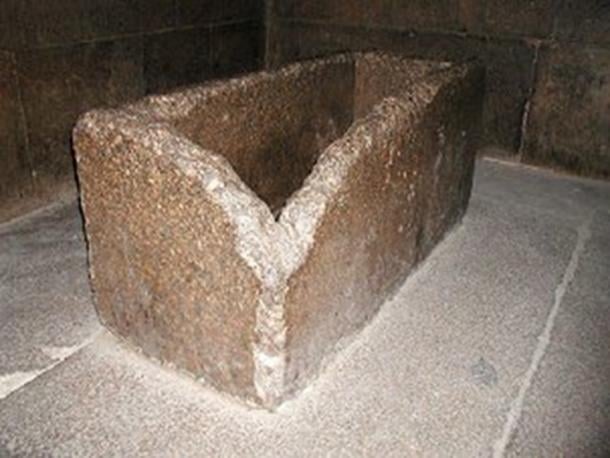
The granite sarcophagus in the King’s Chamber of the Great Pyramid. (Author provided)
Petrie was dumbfounded by the anomalously modern stone-cutting techniques on show in Egypt and wrote, ‘The character of the work would certainly seem to point to diamond as being the cutting jewel; and only the considerations of its rarity in general, and its absence from Egypt, interfere with this conclusion. . .’
- The Evidence is Cut in Stone: A Compelling Argument for Lost High Technology in Ancient Egypt
- Unravelling the mystery behind the megalithic stone walls of Saksaywaman
Questioning the Quality and Immensity of Ancient Stonework
The presence of such bizarrely fashioned stones dating back nearly 5000 years still remains a conundrum today, ‘. . . at the supposed dawn of human civilization, more than 4,500 years ago, the ancient Egyptians had acquired what sounded like industrial-age drills.’
It isn’t just the quality of the cutting which has baffled researchers, but the sheer immensity of some of the stones used to build the many monumental constructions has caused scholarly debate for centuries, and even today the experts struggle to explain how some of these massive blocks were cut, shifted and placed so perfectly into place.
We are talking of such enigmatic archaeological sites as Baalbek in Lebanon, Sacsayhuamán, Ollantaytambo and Machu Picchu in Peru, Tiahuanaco and Puma Punku in Bolivia, Easter Island, Stonehenge in England, and of course the Great Pyramids and temples of Egypt, to name but a few.
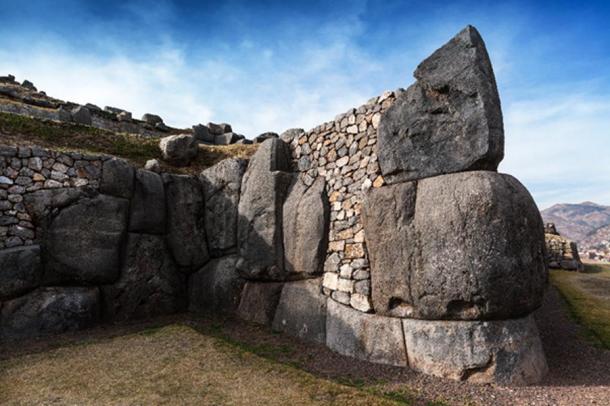
Sacsayhuamán, Peru. (terex /Adobe Stock)
These structures all exhibit signs of engineering skills which should not have been possible in such ancient times with the tools and knowledge which orthodox academics insist were available to them.
We see evidence of heavy lifting which cannot be done today with the world’s largest cranes, and holes and cavities in the hardest rock on earth that only diamond-tipped saws of the modern era should be capable of producing. How was any of this possible?
The Puzzling Case of the Sphinx
As Hancock remarks in The Message of the Sphinx, ‘What we may be looking at here are the fingerprints of highly sophisticated and perhaps even technological people capable of awe-inspiring architectural and engineering feats at a time when no civilization of any kind is supposed to have existed anywhere on Earth.’
On the Giza plateau in front of the Great Sphinx are two temples built from the same limestone rock which was carved out of the horseshoe-shaped enclosure in which sits the Sphinx itself. Both the so-called ‘Sphinx Temple’ and the ‘Valley Temple of Khafre’ are built from massive limestone core-blocks, which were once fitted with granite casings inside and out.
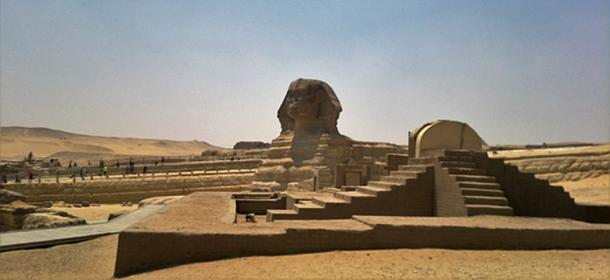
The Great Sphinx of Giza on the Giza Plateau. (VEGANESTON/CC BY SA 4.0)
Bewilderingly, the builders of these ancient and anonymous temples chose to stack stones of immense proportions, some of which are 30 ft. (9.14 meters) long, 12 ft. (3.66 meters) wide and 10 ft. (3.05 meters) high, and weigh in the region of 200 tons each. Even the smallest stones were still a mighty 50 tons apiece. Now the questions that arise today aside from how did these early civilizations manage to haul around such incredibly large stones, must be why? It would be so much easier to build with smaller blocks or bricks like we do in modern times, but for some unknown reason our ancestors chose the difficult option.
Confounding Us with Their Capabilities
What they have succeeded in doing, apart from leaving behind physical evidence of their existence, is confounding us with their capabilities, with the mysteries of the master engineers remaining unsolved.
To get a sense of the sheer size and weight of a 200 ton block we can compare its dimensions to a locomotive train, which as a general rule of thumb weighs in at 30-35 tons per axle, with the average 4-axle locomotive around 125 tons and a 6-axle locomotive around 200 tons. Imagine stacking the largest of these trains one on top of the other, it would be a logistical nightmare.
The standard cranes that we see in our cities on large construction sites can generally hoist a maximum load of 20 tons when the crane arm is at minimum span, but whilst outstretched to its maximum will only lift round 5 tons. Special cranes are required to lift loads exceeding 50 tons, with the most equipped cranes capable of dealing with a 200-ton load being few and far between. Only two land-based cranes in the United States are presently capable of such a feat.

Tower crane atop Mont Blanc, France. (Kristoferb/CC BY SA 3.0)
‘Built with structural steel members and powered with massive electric motors, the majority of these cranes have a load limit of under 100 tons’ writes Hancock, and ‘a commission to put together a temple out of 200 ton blocks would be a most unusual and very taxing job, even for modern heavy-load and crane specialists.’
According to Egyptologists, the stones were raised 50 feet (15.24 meters) above the ground into position by employing a combination of ramps, levers and ropes alongside a huge amount of manpower. But mystified by conventional explanations, John Anthony West sought answers and visited a Long Island construction site to see for himself precisely how a 200 ton weight could really be shifted.
It took 20 men working for six weeks to even prepare to lift a 200 ton boiler using one of the largest cranes in existence with a 220 ft. (67.06 meter) high boom and a counterweight made of concrete weighing an incredible 160 tons. A second crane was then brought in to precisely fit the boiler in place.
- Is This a Huge Million-Year-Old, Man-Made Underground Complex?
- The Forgotten Stones of Aswan Quarry, Egypt
It’s a Mystery at Baalbek too
Discussing the construction of the Valley and Sphinx Temples, chief engineer Jesse Warren commented, “seeing how they moved these heavy 200 ton blocks, possibly thousands and thousands of years ago, I have no idea how they did this job. It’s a mystery, and it’ll probably always be a mystery to me.”
In the Beqaa Valley north of Beirut lie the remains of the ancient Phoenician city of Baalbek, (meaning Lord Baal of the Beqaa Valley), once referred to as Heliopolis or ‘the City of the Sun’ in what is now modern day Lebanon. In the ancient world as early as 9000 BC (although time may reveal the site to be much older), Baalbek became an important pilgrimage site for the worship of the Phoenician sky-god Baal and his consort Astarte, the Queen of Heaven.

A stele of Baal with a thunderbolt found in the ruins of Ugarit. (Public Domain)
At the heart of the city stood a grand temple dedicated to Astarte and Baal which today consists of a five million square foot platform built using some of the largest stones ever shaped by human hands. This immense ancient platform became the foundation for the later Roman temple complex which includes three separate temples dedicated to Jupiter, Bacchus and Venus respectively.
SMLThe stones used at this site are so enormous that they make the 200 ton blocks seen at the Giza temples look like toy bricks in comparison. Some of the blocks in the wall are around 400 tons each, while the three hewn stones known as the ‘trilithon’ which lay in the base of the Jupiter Baal Temple ruins, each weigh an estimated 800 tons. Officially, scholars attribute the shifting and cutting of these monstrous monoliths to the Romans circa 27 BC, but many researchers contest this idea, suggesting instead that they are the remnants of some other ancient civilization from a far earlier epoch altogether, in keeping with the material posited in J.P. Robinson’s book, The Myth of Man: Hidden History and the Ancient Origins of Humankind.
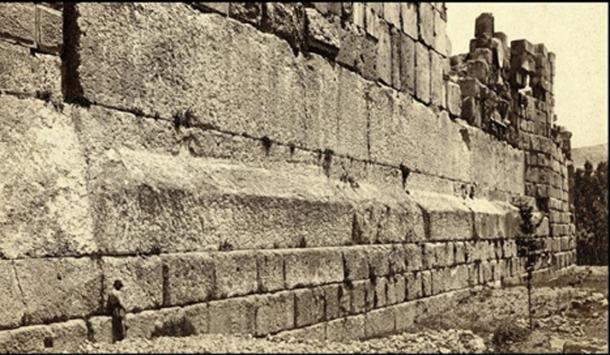
The three hewn stones known as the ‘trilithon’ which lay in the base of the Jupiter Baal Temple ruins each weigh an estimated 800 tons. (Author provided)
Hancock is one such dissident; ‘the moving and positioning of three 800 ton megaliths to a height of 18 or 20 feet above the ground as is the case at Baalbek is a problem of a completely different order. I suggest this requires careful consideration rather than simply saying “the Romans did it” as archaeology is at present inclined to do.’
The combined weight of the entire base at Baalbek is estimated at around five billion tons. Were the Romans capable of shifting such an amount of stone? It is hard to imagine, and no other evidence of Roman construction anywhere else supports such a theory.
The Largest Stones Ever Unearthed
A stone quarry site can be found not too far from the ruins, and it is here where the largest stones ever unearthed were discovered. Sticking out of the ground at a slight angle, a limestone monolith that was named ‘Hajjar al-Hibla’ in Arabic or ‘the Stone of the Pregnant Woman’ was found which weighs an approximate 1,200 tons (or six locomotives)!
Archaeologists agree that this huge monolith was left in the quarry simply because the quality of the stone block’s edge proved too poor to transport as it could be too easily damaged.
In 2014, the Oriental Department of the German Archaeological Institute conducted more excavation work in the stone quarry trying to find new data about the mining techniques and the transporting of the megaliths. But what they found was an even larger monolith directly beside the first one which had been beneath the ground until that summer.
Measuring an astounding 64 ft. (19.6 meters) in length, 19.6 ft. (6 meters) wide and 18 ft. (5.5 meters) high, this unbelievable find weighs 1,650 tons (nearly 1.5 million kilos) and is now the biggest known ancient stone block anywhere in the world. The archaeologists also concluded that due to the block’s configuration and level of smoothness, it was most certainly being readied for transportation without being cut, and all at an altitude of around 3838.58 ft. (1,170 meters).

The biggest known ancient stone block anywhere in the world! (Author provided)
Following the discovery of the second monolith, Hancock wrote, ‘I believe these huge megaliths long predate the construction of the Temple of Jupiter and are likely to be 12,000 or more years old — contemporaneous with the megalithic site of Gobekli Tepe in Turkey. I suggest we are looking at the handiwork of the survivors of a lost civilization, that the Romans built their Temple of Jupiter on a pre-existing, 12,000-years-old megalithic foundation, and that they were unaware of the giant hewn megaliths in the ancient quarry as these were covered by sediment in Roman times (as, indeed, the newly discovered block still was until very recently).’
It remains unexplained how the Romans – or whoever was actually responsible for such an astounding feat of engineering – quarried, cut and transported the megaliths of Baalbek. And another mystery is why they left the largest blocks in situ. The mainstream answer is that they were simply too heavy to maneuver so were left in the ground, but they succeeded in shifting the 800 ton ‘trilithon’ blocks so why not the others? Even if they decided they were beyond the limits of their engineering capabilities, surely they would have cut them up into smaller, more manageable blocks in order to complete the temple constructions. ‘It’s really puzzling that they didn’t do so and therefore the fact that these gigantic, almost finished blocks remain in the quarry and were never sliced up into smaller blocks and used in the general construction of the Temple of Jupiter, suggests to me very strongly that the Romans did not even know they were there,’ explains Hancock.
- Common Tools or Ancient Advanced Technology? How Did the Egyptians Bore Through Granite?
- Forgotten Stones: Secrets of the Megalithic Quarries
Super Megaliths in Siberia
We may never know the answer to these questions, but we can still conjecture as to the technological means in maneuvering the megalithic stones left around the world which continue to perplex us with their mystery.
SMLMore recent discoveries have revealed even more megalithic stones, this time in Southern Siberia near the mountains of Gornaya Shoria. Georgy Sidorov found and photographed the ‘super’ megaliths for the first time on an expedition to the Southern Siberian Mountains in 2014.
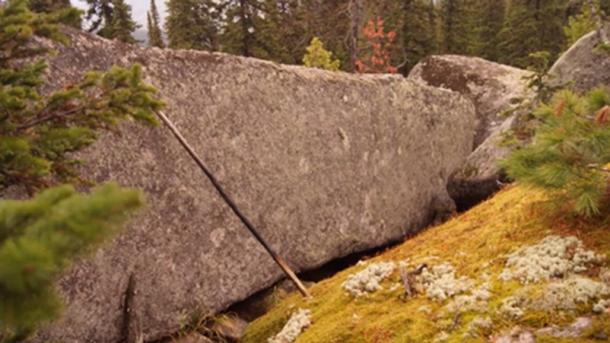
A super Siberian megalith. (Georgy Sidorov)
There are no accurate measurements given as of yet, but judging from the scale depicted by the human figures in some of the photographs, these Siberian megaliths hewn from granite could prove to be twice the weight of the largest known megaliths found at Baalbek, possibly in the region of between 3,000 and 4,000 tons each. How many more such discoveries lie in wait across the globe? And at what weight will these astoundingly immense stones reach?
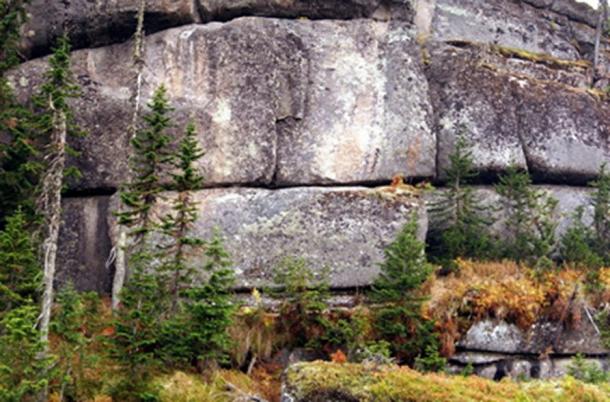
Siberian megaliths hewn from granite. (Author provided)
Reports of the 2014 expedition claim that the geologists encountered some unexplained problems with their compasses when the arrows began deviating away from the megalithic blocks. It has been suggested that they may have experienced inexplicable phenomena of a negative geomagnetic field, leading to notions of the possible use of ancient antigravity technologies unknown to modern science.
Top Image: Stone of the Pregnant Woman, an example of ancient high-tech stonework in Hajar al Hibla at Baalbek in Lebanon. Source: Richard Yoshida /Adobe Stock
By J.P. Robinson
This article was taken from the ‘Advanced Ancients’ chapter in ‘The Myth of Man: Hidden History and the Ancient Origins of Humankind’ by J.P. Robinson.
References
J.P. Robinson, The Myth Of Man, 2018
Graham Hancock, Fingerprints of the Gods, 1995
Peter Tompkins, Secrets of the Great Pyramid, 1973
Flinders Petrie, The Pyramids and Temples Of Gizeh, 1883
Graham Hancock and Robert Bauval, The Message of the Sphinx, 1996
NBC television documentary , Mystery of the Sphinx, 1993
www.grahamhancock.com